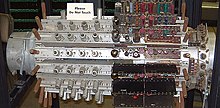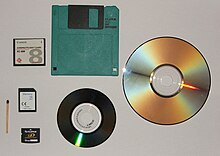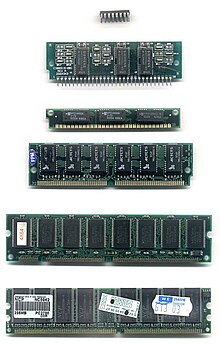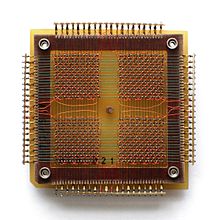Data storage
A data memory or storage medium is used to store data . The term storage medium is also used as a synonym for a specific data carrier .
Definitions
Data carrier / storage medium
In a narrower sense, data carriers or storage media are used to denote data storage media
- for entertainment (music, speech, film, etc.) that is played or stored with the help of electronic devices ; and
- for data of any kind (including entertainment) that are only read or also written by computers or computer systems or peripheral devices .
Data storage
- Data storage for electronic devices :
- electronic components ( semiconductor memory ) that store data (often built into electronic devices)
- Data carriers or storage media that can only be read or written to with electronic devices, but are not semiconductor memories
- Other data storage:
- Written / print media (books, newspapers, paper, glass, animal skin, parchment, ...)
- Image carrier (canvas, carpet, microfilm , photo film , ...)
- Sound carriers (records, pin rollers , magnetic tapes (e.g. in tape cassettes ), ...)
Storage type / storage form
- as script in which language and data are stored in coded form; Special forms:
- Music can be "written" in notes.
- Braille is primarily intended for haptic perception .
- as an ( analog ) image in which a (reproduction) image of the real or the fictional world is stored: analog photographs , paintings , drawings, etc.
- as machine-readable coding (analog or digital ); A mechanical, electrical or electronic device is required to convert the coding into a physical form that humans can understand:
- mechanical conversion: z. B. Record using a gramophone
- electrical conversion: e.g. B. Music cassette
- electronic conversion: e.g. B. CD, DVD, USB stick
Non-technical storage
Humans save the information by hand on or with the help of a carrier material. It can therefore be read directly again without any technical intermediation. The storage takes place without technical intermediation, apart from simple aids for guiding by hand, such as knife or brush. Naturally, all solid materials can be carriers of characters, writings and images.
- Materials and media used then or now
- Paper (sheet, book)
- Foils (sheet)
- Kerbholz
- Rolls of papyrus and parchment
- Boards made of clay , wood , wax , stone (often slate )
- Fabrics and woven goods (pictures, Quipu knot writing )
Famous historical examples include: the Bayeux Tapestry , cave painting , quipu , Abydos hieroglyphs and Qumran scripts
Technical storage
Technical storage comprises all data storage media and storage media that cannot be read directly with the senses or created by hand. A technical aid is required to save the data or make it understandable.
Photographic storage
Chemo-optical memories that use a chemical process to store data in the form of photos (static and moving images as well as light sound).
Storage on microfilm is currently still the safest archiving method. Only a magnifying device is necessary for reading, and there are no problems with the durability of formats and reading devices.
Mechanical storage
With mechanical storage, the data are mechanically written on a large scale; they are physically applied to the storage medium (depressions or elevations in the carrier material). The manufactured storage media can only be read. Example: A CD-ROM is created by a pressing process, as a result of which pits carry the information.
- Mechanical reading
- analog media
- Phonograph cylinder
- LP (long-playing record)
- Shellac record
- digital media
- analog media
- optical reading process (laser); only for "pressed" media - media written by laser see "Optical storage".
- Digital or analog
- digital media
Electronic storage - semiconductor memory
Under the electronic storage of all storage media are combined, save the information to or from electronic (semiconductor) devices. Today, only larger components with several thousand or millions of storage units are combined in one component ( storage module ). As a rule, these components also contain electronics for controlling and managing the memory and thus form an integrated circuit (IC), or they are an important part of the actual circuit, e.g. B. as a register or cache . The latter are especially when it comes to advanced built-in memory function as embedded memory (Engl. Embedded memory ), respectively. Various mechanisms are used to physically store the information and can be differentiated according to the characteristics of the data storage:
- volatile memories whose information is lost if not refreshed or if the power is turned off,
and
-
Non-volatile memories that retain information for a long time (at least months) without the application of an operating voltage. They are further divided into:
- permanent memory in which there is a piece of information that has been stored or hard-wired that cannot be changed and
- semi-permanent memories that store information permanently, but in which information can also be changed.
These classes of electronic storage can be assigned to the storage types:
- volatile memory:
- non-volatile memory:
- permanent storage:
- semi-permanent storage:
- EPROM ( erasable programmable read only memory )
- EEPROM ( electrically erasable programmable read only memory )
- Flash EEPROM (e.g. USB memory sticks )
- FRAM ( ferroelectric random access memory )
- MRAM ( magnetoresistive random access memory )
- Phase-change RAM ( phase-change random access memory )
In order to be able to read electronic storage media, technical aids are also required. The end user therefore generally does not receive the electronic storage media as a single memory module, but rather as a combined product: In the case of DRAM for use as main memory in computers or peripheral devices, several memory modules are combined on one memory module . The flash memories, which are popular for storing multimedia data in mobile applications, come in a wide variety of housings, mostly in the form of memory cards or USB memory sticks , which, in addition to the actual memory module, also contain controllers . The same applies to solid-state drives , which also use flash memory but are supplied in a different device design with different interfaces .
Magnetic storage
The magnetic storage of information takes place on magnetizable material. This can be applied to tapes, cards, paper or plates. Magnetic media (except core memory ) are read or written with a read-write head . A distinction is made between rotating disks (stacks), which are read or written to by means of a movable head, and non-rotating media, which are usually moved past a fixed head for reading or writing. Another distinguishing feature is whether data is usually stored in analog, digital or both forms on the medium.
- magneto-electronic
- digital media
- non-rotating storage media
- digital media
- analog media
- rotating storage media
- digital media
Optical storage
A laser beam is used to read and write the data . The optical storage uses the reflection and diffraction properties of the storage medium, e.g. B. the reflection properties of (non-pressed) CDs and the light-diffractive properties of holographic memories. Today, the form of storage is exclusively digital.
- Holographic memory , formats: HVD
- Non-rotating storage media
The following media are only available as "non-pressed" variants (for pressed media, see "Mechanical storage" above):
- Laser disc
- PD
- CD , sub-formats: audio CD , CD-ROM , CD-R , CD-RW , SVCD , VCD , MVCD
- DVD , sub-formats: DVD-Video , DVD-Audio , DVD-ROM , DVD-RAM , DVD ± R , DVD ± RW
- DVD successors: BD , HD DVD , UDO
The optical sound of old cinema films was analog optical storage ; today they are also stored digitally here.
Magneto-optical storage
Magneto-optical storage uses the fact that some materials can be written on magnetically above a certain temperature ( Curie point ). I.e. To write, the medium is heated up at certain points (usually by means of a laser), and at this point a magnetic field can align the “elementary magnets”; when it cools down, its state becomes fixed. Below this hot temperature, the material can hardly be remagnetized. The memory status can be read out optically with a laser beam, using the polar MOK effect . I.e. the current alignment of the "elementary magnets" at the reading position has an optical effect, which is used for reading - so it is "written magnetically" but "read optically".
See for example
Other storage

- Runtime memory
- Storage tubes based on cathode ray tubes , such as the Williams tube or the Selectron
- biological storage including the artificial DNA of Deinococcus radiodurans bacteria
- Molecular memory
- atomic storage
Further possible subdivision criteria
- Storage capacity
- Data transfer rate
- Access time
- Access type: random access or sequential access
- Writability: read-write memory or read-only memory
- Life span of the storage medium
- Storage form: storage of data in digital or analog form
- Medium use: entertainment media or (computer) data media
- Use of electronic reading / writing devices
- Lifespan of the electronic reading / writing devices used
- Data formats
- Character encoding
literature
- Horst Völz : Knowledge - Recognition - Information - Data Storage from the Stone Age to the 21st Century , Digital Library , Volume 159, Directmedia Publishing , Berlin 2007, ISBN 978-3-89853-559-5 .
Web links
- Historical storage media in the museum , private website, accessed on November 7, 2018
- The early epoch of electromagnetic storage 1952 to 1961 - specialist article on Storage-Insider.de
Individual references / comments
- ^ Jan Dönges: Data storage for eternity . In: Spektrum der Wissenschaft , issue 4/2013, p. 16: Successful experiment consisting of the storage (coding) of approx. 739 kByte of computer data on a DNA strand in a US DNA synthesis company. Then error-free reading (by sequencing) of the same data in England (by bioinformaticians Ewan Birney and Nick Goldman). The author names the suitability for long-term archiving - because of a probable longevity of over 10,000 years and the high density factor.
- ↑ Michael Leitner: Avoid data loss: Molecular storage saves data for centuries. Retrieved June 7, 2019 .
- ↑ First atomic memory with one kilobyte . scinexx.de









